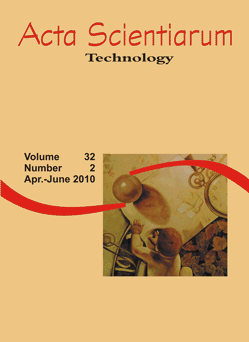<b>The response surface methodology as a tool for assessing the production of alginate and polyhydroxybutirate by <em>Azotobacter vinelandii</em></b> - doi: 10.4025/actascitechnol.v32i2.1792
DOI:
https://doi.org/10.4025/actascitechnol.v32i2.1792Keywords:
Alginate, polyhydroxybutyrate (PHB), production, Azotobacter vinelandiiAbstract
Alginate is a polysaccharide extracted from cell walls of brown algae and used in the food, pharmaceuticals and biotech industries. Production is concentrated on the cultivation of brown seaweed, but several bacteria of the genus Pseudomonas and Azotobacter produce alginate. The chemical structure of alginates produced by algae is similar to those synthesized by A. vinelandii. The bacteria also produce intracellular polymers such as polyhydroxybutyrate (PHB), known as bioplastic. This work studied the simultaneous alginate and PHB production by A. vinelandii using sucrose and different parameters of fermentation in an orbital shaker. The optimal values for the production of these compounds were determined by the MSR. The first experiment was a 26-2 factorial design. The second was based on significant variables of the first, resulting in a full 33-0 factorial design. From the first to the second, an increase was observed in the PHB productivity from 12 to 45 mg g-1 cell h-1 and alginate from 100 to 1,600 mg g-1 of cell h-1. The productivity of both compounds was in the maximum incubation temperature of 62ºC, in the shortest time of incubation (18h) and the sucrose concentration, 11 g L-1. In both experiments the PHB extracted presented purity of 94%.Downloads
Download data is not yet available.
Downloads
Published
2010-07-12
How to Cite
Silva, A. N. da, & Garcia-Cruz, C. H. (2010). <b>The response surface methodology as a tool for assessing the production of alginate and polyhydroxybutirate by <em>Azotobacter vinelandii</em></b> - doi: 10.4025/actascitechnol.v32i2.1792. Acta Scientiarum. Technology, 32(2), 105–112. https://doi.org/10.4025/actascitechnol.v32i2.1792
Issue
Section
Biotechnology
License
DECLARATION OF ORIGINALITY AND COPYRIGHTS
I Declare that current article is original and has not been submitted for publication, in part or in whole, to any other national or international journal.
The copyrights belong exclusively to the authors. Published content is licensed under Creative Commons Attribution 4.0 (CC BY 4.0) guidelines, which allows sharing (copy and distribution of the material in any medium or format) and adaptation (remix, transform, and build upon the material) for any purpose, even commercially, under the terms of attribution.
Read this link for further information on how to use CC BY 4.0 properly.











8.png)




